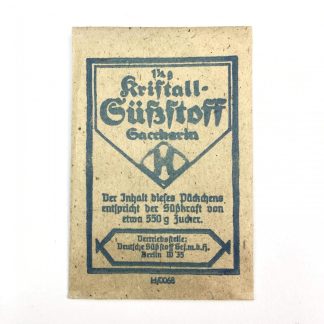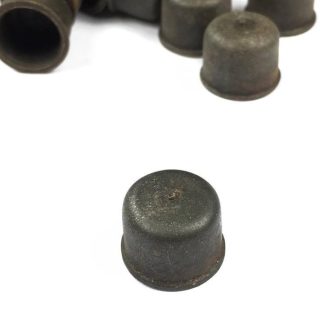Original WWII German NCO Luftwaffe FLAK visor cap
750 €
This German Luftwaffe visor cap is in good condition and was worn by a non-commissioned officer who served first in Flak-Regiment 29 and then in Flak-Regiment 49 which was destroyed in Stalingrad.
The cap was produced in 1937 and also features an early cap eagle on the front.
The cap was produced by Christian Haug in Berlin and the size is 56.5.
Flak-Regiment 49:
Formed on October 1, 1937 in Mannheim from the I. / Flak-Regiment 18 with five batteries. The Abteilung was subordinate to the higher commander of the anti-aircraft artillery in Luftkreis IV, from February 1938 to Luftgaukommando XII. From September 1939, the Abteilung was located on the Westwall. The division under Major Runge supported the units of the XXVI Army Corps from the Kleve area. In the Maas dyke, the Abteilung shot up 10 bunkers and then accompanied the corps through Holland and Belgium to the Dunkirk area. The Abteilung captured a number of 4-cm Flak Bofors with ample ammunition in Holland and, after the vehicle equipment could be completed from the large haul from Dunkirk, set up a 6th battery under Oberleutnant Block with 4-cm Flak. In the second part of the French campaign, the Abteilung was deployed in air-raid and ground combat and was sent to Brest after the armistice. After the end of the Western campaign, this additional battery formed the basis of a new light anti-aircraft division, which was deployed with the 4-cm anti-aircraft guns to protect Berlin. From May 1940, the Abteilung supported the XXVI Army Corps during the Western Campaign. Subsequently, the division was located in France and the Channel Islands under the staff of Flak Regiment 100. In August 1940, it was located in Dinard, from summer 1941 in the St. Nazaire area and then again in Brest to protect the German battleships moored there.
The unit was later transferred to Bordeaux to prepare for a mobile operation between Spain and Gibraltar. In July 1942, the Abteilung moved to the Cakais-Dunkirk area, then temporarily secured the breakthrough of the German battleships through the canal in the Vlissingen area in Holland, and immediately after the first air raid on the Renault factories near Paris, it was deployed there again, using the non-attack periods to prepare for deployment on the Eastern Front. In April 1942, the Abteilung was transferred to southern Russia, where it was subordinated to the staff of Flak Regiment 12 of the 17th Flak Division. The Abteilung was initially deployed in the Isjum – Artemowsk area. At the beginning of the major German attack, it was transferred to the 1st Panzer Army under the staff of the 37th Flak Regiment and worked primarily with the 91st Infantry Division. With this division, it was then assigned to the XXIV Panzer Corps as part of the 9th Flak Division of the 6th Army. In the northern sector of Stalingrad, especially with the 16th Panzer Division, the division distinguished itself several times and was lost in this combat section.
Reorganized in June 1943 with five batteries in Italy. In January 1944, the Abteilung was subordinate to the staff of Flak-Regiment 39 with the 3rd Flak-Brigade and from February 1944 to the staff of Flak-Regiment 57 with the 22nd Flak-Brigade. In the same month, the Abteilung became the III. / Flak-Regiment Hermann Göring.
Article number: 13067
Originele WWII Duitse NCO Luftwaffe schirmmütze
Deze Duitse Luftwaffe schirmmütze is in goede conditie een werd gedragen door een onderofficier welke eerst diende in Flak-Regiment 29 en daarna in Flak-Regiment 49 welke vernietigd werd in Stalingrad.
De pet is geproduceerd in 1937 en tevens voorzien van een vroege pet adelaar aan de voorzijde.
De pet werd geproduceerd door Christian Haug in Berlijn en de maat is 56,5.
Flak-Regiment 49:
Gevormd op 1 oktober 1937 in Mannheim uit het I./Flak-Regiment 18 met vijf batterijen. De Abteilung was ondergeschikt aan de hogere commandant van het luchtafweergeschut in Luftkreis IV, vanaf februari 1938 aan Luftgaukommando XII. Vanaf september 1939 bevond de divisie zich op de Westwall. De divisie onder majoor Runge ondersteunde de eenheden van het XXVI Legerkorps uit het Kleefse gebied. In de Maasdijk schoot de Abteilung 10 bunkers kapot en begeleidde vervolgens het korps door Nederland en België naar Duinkerken. De Abteilung veroverde een aantal 4-cm Flak Bofors met voldoende munitie in Nederland en, nadat de voertuiguitrusting kon worden aangevuld van de grote buit uit Duinkerken, richtte een 6e batterij op onder Oberleutnant Block met 4-cm Flak. In het tweede deel van de Franse campagne werd de Abteilung ingezet in luchtverdediging en grondgevechten en werd na de wapenstilstand naar Brest gestuurd. Na het einde van de westelijke campagne vormde deze extra batterij de basis van een nieuwe lichte luchtafweer divisie, die werd ingezet met het 4-cm luchtafweergeschut om Berlijn te beschermen. Vanaf mei 1940 ondersteunde de divisie het XXVI Legerkorps tijdens de Westelijke Campagne. De divisie werd vervolgens ingezet in Frankrijk en op de Kanaaleilanden onder de staf van het Flak Regiment 100. In augustus 1940 werd het ingezet in Dinard, in de zomer van 1941 in de omgeving van St. Nazaire en vervolgens terug naar Brest om de Duitse slagschepen te beschermen die daar lagen afgemeerd. }De eenheid werd later overgeplaatst naar Bordeaux om zich voor te bereiden op een mobiele operatie tussen Spanje en Gibraltar. In juli 1942 verhuisde de Abteilung naar het Cakais-Duinkerken gebied, beveiligde toen tijdelijk de doorbraak van de Duitse slagschepen door het kanaal in het Vlissingen gebied in Nederland en werd onmiddellijk na de eerste luchtaanval op de Renault fabrieken bij Parijs daar weer ingezet, gebruik makend van de aanvalsvrije periodes om zich voor te bereiden op inzet aan het Oostfront. In april 1942 werd de Abteilung overgeplaatst naar Zuid-Rusland, waar het werd ondergebracht bij de staf van Flak Regiment 12 van de 17e Flak Divisie. De divisie werd aanvankelijk ingezet in het gebied tussen Isyum en Artemovsk. Aan het begin van de grote Duitse aanval werd het overgeplaatst naar het 1e Panzer Leger onder de staf van het 37e Flak Regiment en werkte voornamelijk samen met de 91e Infanterie Divisie. Samen met deze divisie werd het vervolgens toegewezen aan het XXIV Panzer Corps als onderdeel van de 9e Flak Divisie van het 6e Leger. In de noordelijke sector van Stalingrad, vooral met de 16e Pantserdivisie, onderscheidde de divisie zich meerdere malen en ging verloren in dit gevechtsonderdeel.
Gereorganiseerd in juni 1943 met vijf batterijen in Italië. In januari 1944 was de Abteilung ondergeschikt aan de staf van Flak-Regiment 39 met de 3e Flak-Brigade en vanaf februari 1944 aan de staf van Flak-Regiment 57 met de 22e Flak-Brigade. In dezelfde maand werd de Abteilung de III. / Flak-Regiment Hermann Göring.
Artikelnummer: 13067
Out of stock




